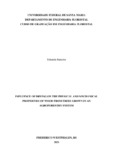Mostrar el registro sencillo del ítem
Influence of drying on the physical and mechanical properties of wood from trees grown in an agroforestry system
| dc.contributor.advisor | Eloy, Elder | |
| dc.creator | Bandera, Eduarda | |
| dc.date.accessioned | 2021-10-25T13:35:32Z | |
| dc.date.available | 2021-10-25T13:35:32Z | |
| dc.date.issued | 2021-02-04 | |
| dc.date.submitted | 2021 | |
| dc.identifier.citation | BANDERA, E. Influence of drying on the physical and mechanical properties of wood from trees grown in an agroforestry system. 2021. 26 p. Trabalho de Conclusão de Curso (Graduação em Engenharia Florestal) - Universidade Federal de Santa Maria, Frederico Westphalen, RS, 2021. | por |
| dc.identifier.uri | http://repositorio.ufsm.br/handle/1/22598 | |
| dc.description | Trabalho de conclusão de curso (graduação) - Universidade Federal de Santa Maria, Campus Frederico Westphalen, Curso de Engenharia Florestal, RS, 2021. | por |
| dc.description.abstract | The cultivation of native and exotic species intercropped in an agroforestry system raises the interest for information on the properties of wood. Therefore, different methods are being tested to improve the technological properties of this material, including drying, which causes changes in the physical and mechanical properties of the wood. The present study investigated the influence of drying on the physical and mechanical properties of wood from tree species grown in an agroforestry system. Parapiptadenia rigida (Benth.) Brenan, Peltophorum dubium (Spreng.) Taub., Eucalyptus grandis W. Hill × Eucalyptus urophylla S.T. Blake (hybrid), and Schizolobium parahyba (Vell.) S.F.Blake were the species selected for the study. Three 9-year-old individuals of each of the species were obtained from an agroforestry system. Thirty wood samples (2.5 × 2.5 × 41 cm) were extracted from each species. The wood samples were divided between temperature treatments; 6 samples were used for each heat treatment (control, 120, 150, 180, and 210 °C), which were then dried for two hours in an oven (with forced air circulation). Following the heat treatment, the mechanical properties of wood samples were evaluated to determine the modulus of elasticity and rupture, the tension in the proportional limit, and maximum force according to the ASTM D 143-94 (2000) standard. Finally, the physical properties of the retractability of the wood samples were evaluated according to the NBR 7190 (ABNT, 1997) standard. Specimens used to analyze this variable came from sections of the wood (sample dimensions: 2.5 × 2.5 × 5 cm) not affected by the static bending test. Our findings indicate that, for all species investigated in this study, drying alters the physical and mechanical properties of the wood, with the most significant changes occurring at temperatures between 120 and 180 °C. | eng |
| dc.language | eng | por |
| dc.publisher | Universidade Federal de Santa Maria | por |
| dc.rights | Acesso Aberto | por |
| dc.rights | Attribution-NonCommercial-NoDerivatives 4.0 International | * |
| dc.rights.uri | http://creativecommons.org/licenses/by-nc-nd/4.0/ | * |
| dc.subject | Wood resistance | eng |
| dc.subject | Dimensional stability | eng |
| dc.subject | Eat treatment | eng |
| dc.title | Influence of drying on the physical and mechanical properties of wood from trees grown in an agroforestry system | eng |
| dc.type | Trabalho de Conclusão de Curso de Graduação | por |
| dc.degree.local | Frederico Westphalen, RS, Brasil. | por |
| dc.degree.graduation | Engenharia Florestal. | por |
| dc.description.resumo | The cultivation of native and exotic species intercropped in an agroforestry system raises the interest for information on the properties of wood. Therefore, different methods are being tested to improve the technological properties of this material, including drying, which causes changes in the physical and mechanical properties of the wood. The present study investigated the influence of drying on the physical and mechanical properties of wood from tree species grown in an agroforestry system. Parapiptadenia rigida (Benth.) Brenan, Peltophorum dubium (Spreng.) Taub., Eucalyptus grandis W. Hill × Eucalyptus urophylla S.T. Blake (hybrid), and Schizolobium parahyba (Vell.) S.F.Blake were the species selected for the study. Three 9-year-old individuals of each of the species were obtained from an agroforestry system. Thirty wood samples (2.5 × 2.5 × 41 cm) were extracted from each species. The wood samples were divided between temperature treatments; 6 samples were used for each heat treatment (control, 120, 150, 180, and 210 °C), which were then dried for two hours in an oven (with forced air circulation). Following the heat treatment, the mechanical properties of wood samples were evaluated to determine the modulus of elasticity and rupture, the tension in the proportional limit, and maximum force according to the ASTM D 143-94 (2000) standard. Finally, the physical properties of the retractability of the wood samples were evaluated according to the NBR 7190 (ABNT, 1997) standard. Specimens used to analyze this variable came from sections of the wood (sample dimensions: 2.5 × 2.5 × 5 cm) not affected by the static bending test. Our findings indicate that, for all species investigated in this study, drying alters the physical and mechanical properties of the wood, with the most significant changes occurring at temperatures between 120 and 180 °C. | por |
| dc.publisher.country | Brasil | por |
| dc.publisher.initials | UFSM | por |
| dc.subject.cnpq | CNPQ::CIENCIAS AGRARIAS::RECURSOS FLORESTAIS E ENGENHARIA FLORESTAL | por |
| dc.publisher.unidade | UFSM Frederico Westphalen | por |
Ficheros en el ítem
Este ítem aparece en la(s) siguiente(s) colección(ones)
-
TCC Engenharia Florestal [45]
TCCs curso de Engenharia Florestal está localizado em Campus Frederico Westphalen



